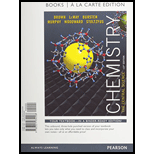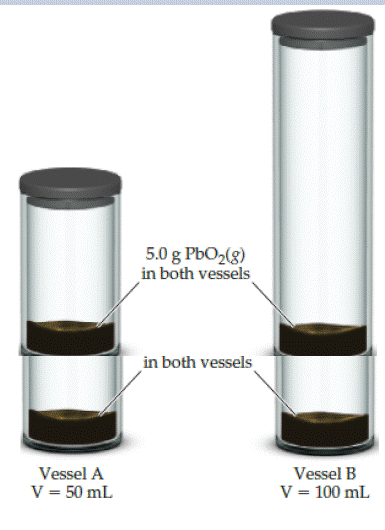
Chemistry: The Central Science, Books a la Carte Edition & Modified Mastering Chemistry with Pearson eText -- ValuePack Access Card Package
1st Edition
ISBN: 9780133910919
Author: Theodore E. Brown, H. Eugene LeMay, Bruce E. Bursten, Catherine Murphy, Patrick Woodward, Matthew E. Stoltzfus
Publisher: PEARSON
expand_more
expand_more
format_list_bulleted
Textbook Question
Chapter 23, Problem 37E
When lead(IV) oxide is heated above 300 O C, it decomposes according to the following reaction PbO2(s) ⇌ PbO(s) + O2(g). Consider the two sealed vessels of PBO2 shown here. If both vessels are heated to 400 O C and allowed to come to equilibrium, which of the following statements is true?
- There will be less PbO2 remaining in vessel A,
- There will be less PbO2 remaining in vessel B,
- The amount of PbO2 remaining in each vessel will be the same.
[Section 15.4]

Expert Solution & Answer
Want to see the full answer?
Check out a sample textbook solution
Students have asked these similar questions
Two cations that exchange an electron in an interface, the exchange density is worth 1.39 mA/cm2 and the current density is worth 15 mA/cm2 at 25°C. If the overvoltage is 0.14 V, calculate the reaction rate and symmetry factor. Data: R = 8,314 J mol-1 k-1: F = 96500 C
With the help of the Tafel line, it is estimated that the interchange density of the VO2+/VO2+ system on the carbon paper has a value of 3 mA cm-2. Calculate a) the current density if the voltage has a value of 1.6 mV and the temperature is 25°C. b) the beta value of the anódico process if the Tafel pendulum is 0.6 V at 25°C. Data: R = 8.314 JK-1mol-1, y F = 96485 C mol-1.
Apply the NANSTE law to the MnO4- + 8H+ + 5e- ⇄ Mn2+ + 4H2O
Chapter 23 Solutions
Chemistry: The Central Science, Books a la Carte Edition & Modified Mastering Chemistry with Pearson eText -- ValuePack Access Card Package
Ch. 23.2 - Prob. 23.1.1PECh. 23.2 - Prob. 23.1.2PECh. 23.2 - Prob. 23.2.1PECh. 23.2 - Prob. 23.2.2PECh. 23.4 - The following mechanism has been proposed for the...Ch. 23.4 - Prob. 23.3.2PECh. 23.4 - Prob. 23.4.1PECh. 23.4 - Platinum nanoparticles of diameter ~2 nm are...Ch. 23.4 - 14.114 One of the many remarkable enzymes in the...Ch. 23.4 - 14.115N Suppose that, in the absence of catalyst,...
Ch. 23.5 - Prob. 23.6.1PECh. 23.5 - Dinitrogen pentoxide (N2O5) decomposes in...Ch. 23.6 - The reaction between ethyl iodide and hydroxide...Ch. 23.6 - Prob. 23.7.2PECh. 23.6 - Prob. 23.8.1PECh. 23.6 - Prob. 23.8.2PECh. 23 - Prob. 1DECh. 23 - Practice Exercise 1
If 8.0 g of NH4HS(s)...Ch. 23 - Practice Exercise 1 For the reaction 4 NH3(g) + 5...Ch. 23 - Prob. 3ECh. 23 - Prob. 4ECh. 23 - Phosphorus trichloride gas and chlorine gas react...Ch. 23 - Prob. 6ECh. 23 - Prob. 7ECh. 23 - 15.70 True or false: When the temperature of an...Ch. 23 - Prob. 9ECh. 23 - Prob. 10ECh. 23 - Prob. 11ECh. 23 - Prob. 12ECh. 23 - Prob. 13ECh. 23 - Prob. 14ECh. 23 - Prob. 15ECh. 23 - Practice Exercise 2 For the reaction H2 (g) + I2...Ch. 23 - Prob. 17ECh. 23 - Prob. 18ECh. 23 - Prob. 19ECh. 23 - Practice Exercise 1
A mixture of gaseous sulfur...Ch. 23 - Prob. 21ECh. 23 - Prob. 22ECh. 23 - Practice Exercise 2
The gaseous compound BrCl...Ch. 23 - Prob. 24ECh. 23 - Practice Exercise 2 At 1000 k, the value of Kp for...Ch. 23 - Prob. 26ECh. 23 - Prob. 27ECh. 23 - Practice Exercise 1 For the equilibrium Br2(g) +...Ch. 23 - Prob. 29ECh. 23 - Prob. 30ECh. 23 - Prob. 31ECh. 23 - Prob. 32ECh. 23 - Prob. 33ECh. 23 - Prob. 34ECh. 23 - Prob. 35ECh. 23 - 15.6 Ethene (C2H4) reacts with healogens (X2) by...Ch. 23 - When lead(IV) oxide is heated above 300 O C, it...Ch. 23 - Prob. 38ECh. 23 - The reactin A2(g) + B(g) + A(g) + AB(g) has an...Ch. 23 - The following graph represents the yield of the...Ch. 23 - Suppose that the gas-phase reactions A B and B A...Ch. 23 - Prob. 42ECh. 23 - Prob. 43ECh. 23 - Prob. 44ECh. 23 - Prob. 45ECh. 23 - Prob. 46ECh. 23 - Prob. 47ECh. 23 - Prob. 48ECh. 23 - Prob. 49ECh. 23 - Prob. 50ECh. 23 - Prob. 51ECh. 23 - Prob. 52ECh. 23 - Prob. 53ECh. 23 - Prob. 54ECh. 23 - Prob. 55ECh. 23 - Prob. 56ECh. 23 - Prob. 57ECh. 23 - Prob. 58ECh. 23 - For each of the following metals, write the...Ch. 23 - Prob. 60ECh. 23 - Prob. 61ECh. 23 - Prob. 62ECh. 23 - Prob. 63ECh. 23 - Prob. 64ECh. 23 - Prob. 65AECh. 23 - Prob. 66AECh. 23 - Prob. 67AECh. 23 - Prob. 68AECh. 23 - Prob. 69AECh. 23 - Prob. 70AECh. 23 - Prob. 71AECh. 23 - Prob. 72AECh. 23 - Prob. 73AECh. 23 - Prob. 74AECh. 23 - Prob. 75AECh. 23 - Prob. 76AECh. 23 - Prob. 77AECh. 23 - Prob. 78AECh. 23 - Prob. 79AECh. 23 - Prob. 80AECh. 23 - Prob. 81AECh. 23 - Prob. 82AECh. 23 - Prob. 83AECh. 23 - Prob. 84AECh. 23 - Prob. 85AECh. 23 - Prob. 86AECh. 23 - Prob. 87AECh. 23 - Prob. 88AECh. 23 - Prob. 89AECh. 23 - Prob. 90IECh. 23 - Prob. 91IECh. 23 - Prob. 92IECh. 23 - Prob. 93IECh. 23 - Prob. 94IECh. 23 - Prob. 95IECh. 23 - Prob. 96IECh. 23 - Prob. 97IECh. 23 - Prob. 98IECh. 23 - Prob. 99IECh. 23 - Prob. 100IECh. 23 - Prob. 101IE
Knowledge Booster
Learn more about
Need a deep-dive on the concept behind this application? Look no further. Learn more about this topic, chemistry and related others by exploring similar questions and additional content below.Similar questions
- An electrode process takes place at a metal-solution interface. Indicate the current condition that must be met for Faradaic rectification to occur.arrow_forwardAt a metal-solution interface, an electron is exchanged, and the symmetry factor beta < 0.5 is found in the Butler-Volmer equation. What does this indicate?arrow_forwardTopic: Photochemistry and Photophysics of Supramoleculesarrow_forward
arrow_back_ios
SEE MORE QUESTIONS
arrow_forward_ios
Recommended textbooks for you
 Chemistry: The Molecular ScienceChemistryISBN:9781285199047Author:John W. Moore, Conrad L. StanitskiPublisher:Cengage Learning
Chemistry: The Molecular ScienceChemistryISBN:9781285199047Author:John W. Moore, Conrad L. StanitskiPublisher:Cengage Learning Chemistry & Chemical ReactivityChemistryISBN:9781337399074Author:John C. Kotz, Paul M. Treichel, John Townsend, David TreichelPublisher:Cengage Learning
Chemistry & Chemical ReactivityChemistryISBN:9781337399074Author:John C. Kotz, Paul M. Treichel, John Townsend, David TreichelPublisher:Cengage Learning General Chemistry - Standalone book (MindTap Cour...ChemistryISBN:9781305580343Author:Steven D. Gammon, Ebbing, Darrell Ebbing, Steven D., Darrell; Gammon, Darrell Ebbing; Steven D. Gammon, Darrell D.; Gammon, Ebbing; Steven D. Gammon; DarrellPublisher:Cengage Learning
General Chemistry - Standalone book (MindTap Cour...ChemistryISBN:9781305580343Author:Steven D. Gammon, Ebbing, Darrell Ebbing, Steven D., Darrell; Gammon, Darrell Ebbing; Steven D. Gammon, Darrell D.; Gammon, Ebbing; Steven D. Gammon; DarrellPublisher:Cengage Learning Chemistry & Chemical ReactivityChemistryISBN:9781133949640Author:John C. Kotz, Paul M. Treichel, John Townsend, David TreichelPublisher:Cengage Learning
Chemistry & Chemical ReactivityChemistryISBN:9781133949640Author:John C. Kotz, Paul M. Treichel, John Townsend, David TreichelPublisher:Cengage Learning Chemistry: Principles and PracticeChemistryISBN:9780534420123Author:Daniel L. Reger, Scott R. Goode, David W. Ball, Edward MercerPublisher:Cengage Learning
Chemistry: Principles and PracticeChemistryISBN:9780534420123Author:Daniel L. Reger, Scott R. Goode, David W. Ball, Edward MercerPublisher:Cengage Learning ChemistryChemistryISBN:9781305957404Author:Steven S. Zumdahl, Susan A. Zumdahl, Donald J. DeCostePublisher:Cengage Learning
ChemistryChemistryISBN:9781305957404Author:Steven S. Zumdahl, Susan A. Zumdahl, Donald J. DeCostePublisher:Cengage Learning

Chemistry: The Molecular Science
Chemistry
ISBN:9781285199047
Author:John W. Moore, Conrad L. Stanitski
Publisher:Cengage Learning

Chemistry & Chemical Reactivity
Chemistry
ISBN:9781337399074
Author:John C. Kotz, Paul M. Treichel, John Townsend, David Treichel
Publisher:Cengage Learning

General Chemistry - Standalone book (MindTap Cour...
Chemistry
ISBN:9781305580343
Author:Steven D. Gammon, Ebbing, Darrell Ebbing, Steven D., Darrell; Gammon, Darrell Ebbing; Steven D. Gammon, Darrell D.; Gammon, Ebbing; Steven D. Gammon; Darrell
Publisher:Cengage Learning

Chemistry & Chemical Reactivity
Chemistry
ISBN:9781133949640
Author:John C. Kotz, Paul M. Treichel, John Townsend, David Treichel
Publisher:Cengage Learning

Chemistry: Principles and Practice
Chemistry
ISBN:9780534420123
Author:Daniel L. Reger, Scott R. Goode, David W. Ball, Edward Mercer
Publisher:Cengage Learning

Chemistry
Chemistry
ISBN:9781305957404
Author:Steven S. Zumdahl, Susan A. Zumdahl, Donald J. DeCoste
Publisher:Cengage Learning
Chemical Equilibria and Reaction Quotients; Author: Professor Dave Explains;https://www.youtube.com/watch?v=1GiZzCzmO5Q;License: Standard YouTube License, CC-BY